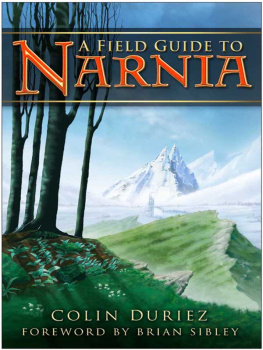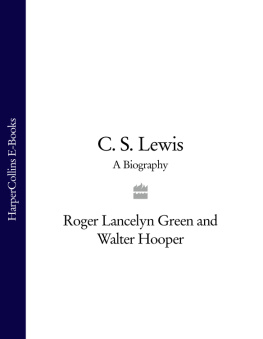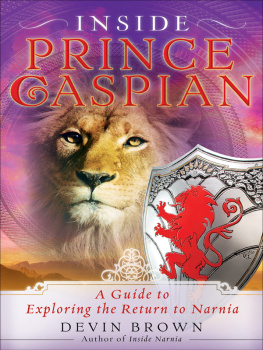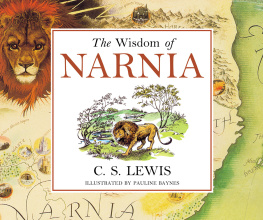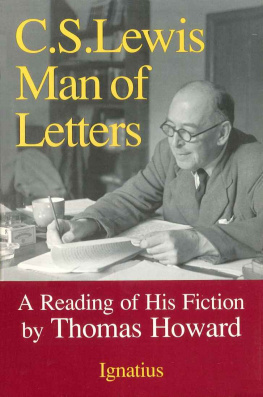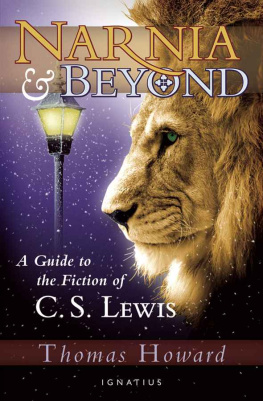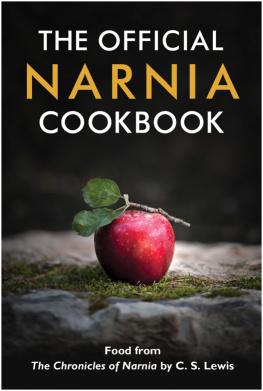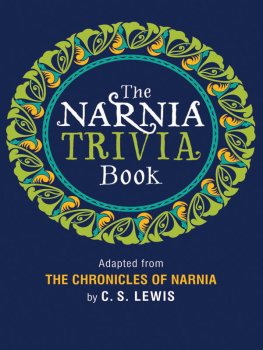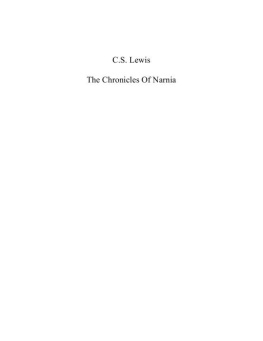Lewis Clive Staples - A Field Guide to Narnia
Here you can read online Lewis Clive Staples - A Field Guide to Narnia full text of the book (entire story) in english for free. Download pdf and epub, get meaning, cover and reviews about this ebook. City: Stroud, year: 2013, publisher: The History Press, genre: Religion. Description of the work, (preface) as well as reviews are available. Best literature library LitArk.com created for fans of good reading and offers a wide selection of genres:
Romance novel
Science fiction
Adventure
Detective
Science
History
Home and family
Prose
Art
Politics
Computer
Non-fiction
Religion
Business
Children
Humor
Choose a favorite category and find really read worthwhile books. Enjoy immersion in the world of imagination, feel the emotions of the characters or learn something new for yourself, make an fascinating discovery.
- Book:A Field Guide to Narnia
- Author:
- Publisher:The History Press
- Genre:
- Year:2013
- City:Stroud
- Rating:4 / 5
- Favourites:Add to favourites
- Your mark:
- 80
- 1
- 2
- 3
- 4
- 5
A Field Guide to Narnia: summary, description and annotation
We offer to read an annotation, description, summary or preface (depends on what the author of the book "A Field Guide to Narnia" wrote himself). If you haven't found the necessary information about the book — write in the comments, we will try to find it.
A Field Guide to Narnia — read online for free the complete book (whole text) full work
Below is the text of the book, divided by pages. System saving the place of the last page read, allows you to conveniently read the book "A Field Guide to Narnia" online for free, without having to search again every time where you left off. Put a bookmark, and you can go to the page where you finished reading at any time.
Font size:
Interval:
Bookmark:

A FIELD GUIDE TO
NARNIA
COLIN DURIEZ
FOREWORD BY BRIAN SIBLEY

T o Ben Duriez
First published in the United Kingdom in 2005 by Sutton Publishing Limited
Originally published in the United States of America by InterVarsity Press in 2004.
The History Press
The Mill, Brimscombe Port
Stroud, Gloucestershire, GL5 2QG
www.thehistorypress.co.uk
This ebook edition first published in 2013
All rights reserved
Colin Duriez, 2004, 2005, 2013
The right of Colin Duriez to be identified as the Author of this work has been asserted in accordance with the Copyrights, Designs and Patents Act 1988.
This ebook is copyright material and must not be copied, reproduced, transferred, distributed, leased, licensed or publicly performed or used in any way except as specifically permitted in writing by the publishers, as allowed under the terms and conditions under which it was purchased or as strictly permitted by applicable copyright law. Any unauthorised distribution or use of this text may be a direct infringement of the authors and publishers rights, and those responsible may be liable in law accordingly.
EPUB ISBN 978 0 7524 9554 5
Original typesetting by The History Press
Contents
Foreword
I once tried to get through the back of my parents wardrobe! It was an embarrassing confession! And the words had barely left my lips before I felt oddly foolish and vulnerable.
My confessor was the late Roger Lancelyn Green. I was in the library of his family home: a room lined with the many books he had written about childrens authors, shelved cheek by jowl with books by many of those writers whose creations he had chronicled: Lewis Carroll, J.M. Barrie, Andrew Lang and Rudyard Kipling, as well as several who had been his friends, including J.R.R. Tolkien and C.S. Lewis.
The confession was prompted by reading Lewiss spidery inscription in a first edition of The Lion, the Witch, and the Wardrobe , acknowledging that without Rogers enthusiasm and encouragement (at a time when Lewiss closest friend, Tolkien, had proved an unsympathetic critic) Narnia might never have come into being.
Rogers silent response was to lead me into the drawing room and point to a large looking-glass in a gilded frame above the mantelpiece. One day, he said, after reading Through the Looking-Glass , I climbed up onto the mantelpiece and tried to follow Alice into Looking-Glass House!
I found this most reassuring! Since that day, I have met many others who have tried to find their way into Narnia either via a wardrobe or just as I did when the wooden backboard proved unyielding by simply squeezing their eyes tightly shut and hoping that Aslan would summon them into his world with a mighty roar!
So, what makes some forays into imaginary worlds so compelling that, when young, we are convinced we might also find a way there and, when older, we ache at the memory of that conviction?
It is surely their urgent, immediate and totally accidental nature. Alice, in pursuit of the White Rabbit, rushed headlong down the rabbit hole never once considering how in the world she was to get out again. Lucy looked into the wardrobe out of little more than idle curiosity and soon found the fur coats transmogrifying into fir trees. One suspects that all those references to leaving the door open (because she knew that it is very foolish to shut oneself into any wardrobe) were added later on the insistence of an anxious publisher perhaps wisely in view of my own experiences!
The choice of a wardrobe, more than any of the later routes from this world into that world, is compelling and unselfconscious: a door that, unlike other doors, leads neither in nor out of a room, but into a room within a room and, perhaps therefore, a world within a world
In the more than half a century since the publication of The Lion, the Witch, and the Wardrobe , the book (along with the other six volumes of the Chronicles of Narnia) has become a classic, but without gathering any of the dulling dust of respectability that tends to settle on books that have achieved classic status.
As fresh as the grass that springs up in the newborn Narnia at the bidding of Aslans creation song, these books can be read (as they are daily read by many) without exposition or explanation either of the curious alchemy that conjures up a host of disparate beings from myth, legend and folk tale spanning half the world and several millennia, or of the mystical weft and warp of the canvas onto which this eclectic and exotic tapestry is woven.
However, since the books are now classics and since their creator has become one of the most pondered-over, written-about, analysed and deconstructed authors of the twentieth century, the more curious reader will find it helpful and instructive to have a reliable guide on hand when exploring the lands that lie between the lamp-post and the great castle of Cair Paravel on the eastern sea.
One could not wish for a better travelling companion than a pre-eminent commentator such as Colin Duriez, who combines a richly mined knowledge sharply focused by wisdom and understanding of both the world and the worlds of C.S. Lewis, and shares it with a passionate but clear-sighted enthusiasm that is as effortless as it is authoritative.
So, before you step into that wardrobe (and remember, as every sensible person does, that you should never, never shut yourself in a wardrobe) pop A Field Guide to Narnia in your pocket and you will, undoubtedly, see that land with new eyes, perhaps even respond to it with a new heart
Brian Sibley
Preface
I still remember first reading The Lion, the Witch, and the Wardrobe . The bracing air of the snowy wood intensified my exultant feeling of discovering another magical place as I followed Lucy. I already knew the riverbank and the Wild Wood in The Wind in the Willows . I had discovered the enchanting undersea cavern in The Coral Island . Later I was to discover the Shire, and the larger world of Rivendell and the Misty Mountains, in Tolkien.
The Chronicles of Narnia are classics of childrens literature, along with The Hobbit , Alices Adventures in Wonderland , The Wind in the Willows , the stories of E. Nesbit and George MacDonald, J.K. Rowlings tales of Hogwarts School, and others. Humphrey Carpenter and Mari Prichard believe that the Chronicles must be judged the most sustained achievement in fantasy for children by a 20th-cent[ury] author.
His seven stories of Narnia are already, forty years after his death, the most well known and widely read of C.S. Lewiss more than forty writings, and are as characteristic of his thought and imagination as his science-fiction books, his literary criticism and his popular theology, such as The Screwtape Letters and Mere Christianity .
The Chronicles have become part of the lives of generations of children since the stories first appeared between 1950 and 1956. Parents and teachers over the years also have read them to their children. In the 1980s the British Broadcasting Corporation adapted several of the books for television, and later for radio. The Lion, the Witch, and the Wardrobe is being made into a major film, directed by Andrew Adamson, with other Narnian stories to follow.
Some have supposed that Lewis turned to writing childrens stories because he had lost confidence in writing books that argued, often philosophically, for the Christian faith. Nothing could be further from the truth. Writing for children is one of the most demanding of an authors tasks. The Narnian tales built on skills that Lewis had honed in writing earlier stories for grown-ups, such as his science-fiction trilogy. They also built on Lewiss exposure to the ideas and writings of his friend J.R.R. Tolkien, particularly the tales of the Silmarillion and his epic romance, The Lord of the Rings , though Tolkien was then unpublished except for The Hobbit . Romance for Lewis, as for Tolkien, meant literature that contains glimpses of other worlds, strangely stirring the spirit. Such stories hinted at realities beyond the walls of the world.
Next pageFont size:
Interval:
Bookmark:
Similar books «A Field Guide to Narnia»
Look at similar books to A Field Guide to Narnia. We have selected literature similar in name and meaning in the hope of providing readers with more options to find new, interesting, not yet read works.
Discussion, reviews of the book A Field Guide to Narnia and just readers' own opinions. Leave your comments, write what you think about the work, its meaning or the main characters. Specify what exactly you liked and what you didn't like, and why you think so.

